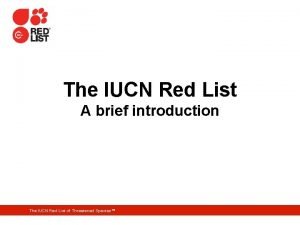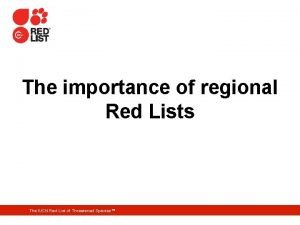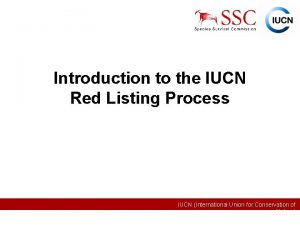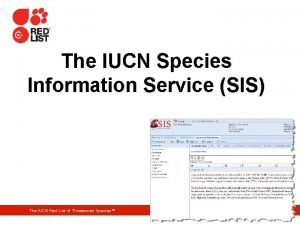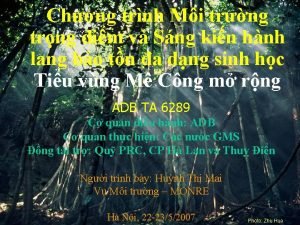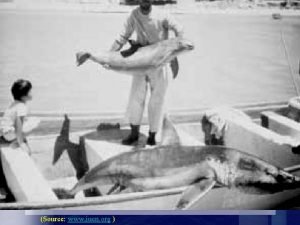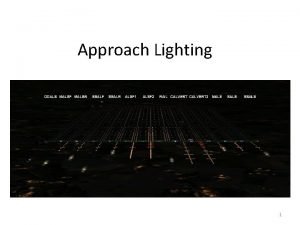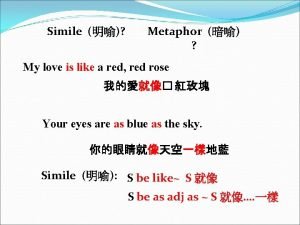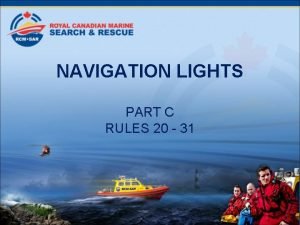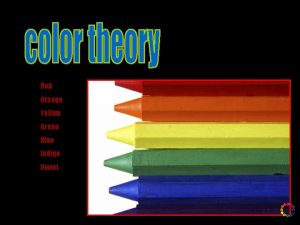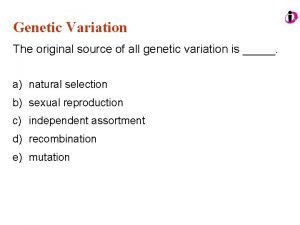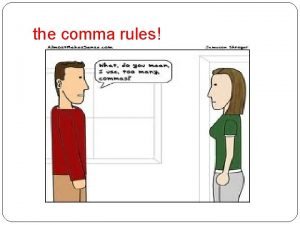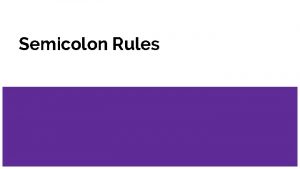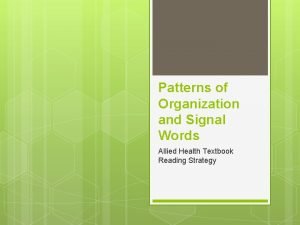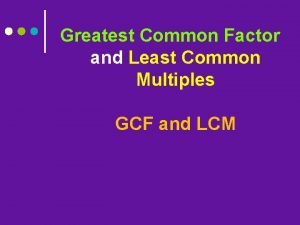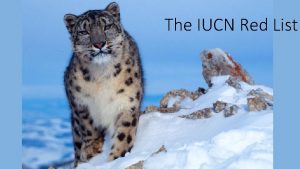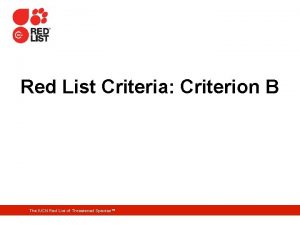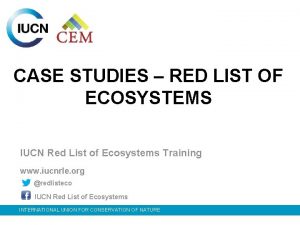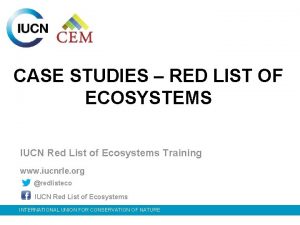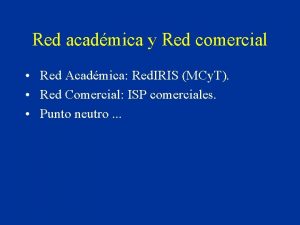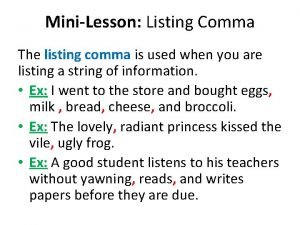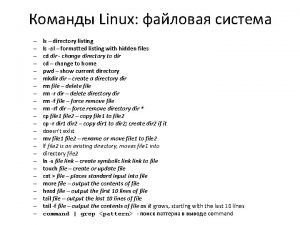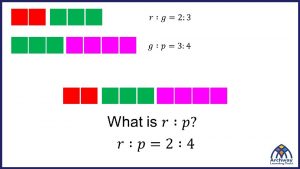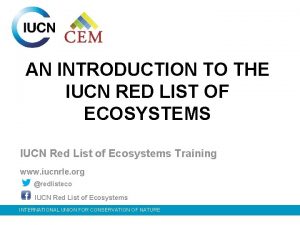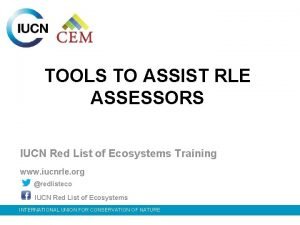Introduction to the IUCN Red Listing Process IUCN









































































- Slides: 73

Introduction to the IUCN Red Listing Process IUCN (International Union for Conservation of Nature)

The IUCN Red List assessment estimates risk of extinction What is the likelihood of a species becoming extinct in the near future, given current knowledge about population trends, range, and recent, current or projected threats? IUCN (International Union for Conservation of Nature)

The IUCN Red List Categories & Criteria All materials are freely available on IUCN Red List web site: www. iucnredlist. org IUCN (International Union for Conservation of Nature)

Scope of Application The IUCN Red List Categories and Criteria are: • • • Used to assess taxa at the global level Can be used at regional levels (but see the Guidelines for Application of IUCN Red List Criteria at Regional Levels) Used to assess wild populations inside their natural range (including populations resulting from benign introductions) IUCN Categories and Criteria can be applied to: • • All described taxa (species, subspecies, varieties), except micro-organisms Taxa not yet formally described, but only if they are: • A clearly distinct species • Museum/herbarium voucher references are provided • Distribution information is available • There is clear conservation benefit to assessing the species IUCN (International Union for Conservation of Nature)

Rabb’s Fringe-limbed Treefrog Ecnomiohyla rabborum Category: Critically Endangered CR A 2 ace; B 1 ab(iii) Criteria & subcriteria IUCN (International Union for Conservation of Nature)

The IUCN Categories Extinct (EX) Extinct in the Wild (EW) Critically Endangered (CR) Endangered (EN) Vulnerable (VU) Near Threatened (NT) Least Concern (LC) Data Deficient (DD) Not Evaluated (NE) IUCN (International Union for Conservation of Nature)

Extinct (EX) A taxon is Extinct when there is no reasonable doubt that the last individual has died Extinct in the Wild (EW) Dodo, Raphus cucullatus A taxon is Extinct in the Wild when it is known only to survive in cultivation, in captivity or as a naturalized population (or populations) well outside the past range IUCN (International Union Photo for ©Conservation of Craig Hilton-Taylor Franklinia, Nature) Franklinia alatamaha

A taxon is threatened when the best available evidence indicates that it meets any of the criteria A to E for the thresholds stated in one of the threatened categories: Critically Endangered, Endangered or Vulnerable. Critically Endangered (CR) CR taxa are considered to be facing an extremely high risk of extinction in the wild Photo © Wendy Strahm Endangered (EN) Mandrinette, Hibiscus fragilis EN taxa are considered to be facing a very high risk of extinction in the wild Black-browed Albatross, Thalassarche melanophrys Photo © Tony Palliser Vulnerable (VU) Golden Pagoda, VU taxa are considered to be facing a high IUCN risk (International of Union for Conservation of Mimetes extinction in the wild chrysanthus. Nature) Photo © Craig Hilton. Taylor

Near Threatened (NT) A taxon is Near Threatened when it has been evaluated against the criteria and does not qualify for CR, EN or VU now, but is close to qualifying for or is likely to qualify for a threatened category in the near future Photo © H. Fraga Macaronesian Laurel, Laurus azorica Least Concern (LC) A taxon is Least Concern when it has been evaluated against the criteria and does not qualify for CR, EN, VU or NT. Widespread and abundant taxa are included in this category Photo © Caroline Pollock IUCN (International Union for Conservation of Olive Baboon, Papio anumbis Nature)

Data Deficient (DD) A taxon is Data Deficient when there is inadequate information to make a direct, or indirect, assessment of its risk of extinction based on its distribution and/or population status Tree Tomato Solanum [Cyphomandra] betacea Not Evaluated (NE) A taxon is Not Evaluated when it has not yet been evaluated against the criteria IUCN (International Union for Conservation of Nature)

Data Deficient (DD) Not Evaluated (NE) Although DD and NE are not threatened categories, taxa classed as DD or NE should NOT be treated as not threatened IUCN (International Union for Conservation of Nature)

Types of data required for IUCN Red List assessments IUCN (International Union for Conservation of Nature)

Dealing with a lack of high quality data • The threatened categories use quantitative thresholds • BUT a lack of high quality data should not deter assessors from applying the IUCN criteria IUCN (International Union for Conservation of Nature)

Acceptable types of data quality Observed Estimated Projected Inferred Suspected IUCN (International Union for Conservation of Nature)

Observed information is directly based on well-documented observations of all known individuals in the population Estimated information is based on calculations that may involve assumptions Projected information is the same as “estimated”, but the variable of interest is extrapolated in time towards the future IUCN (International Union for Conservation of Nature)

Inferred information is based on variables that are indirectly related to the variable of interest, but in the same general type of units (e. g. number of individuals or area or number of subpopulations) Suspected information is based on circumstantial evidence, or on variables in different types of units. In general, this can be based on any factor related to population abundance or distribution IUCN (International Union for Conservation of Nature)

Dealing with uncertainty Information uncertainty must be taken into account when making an assessment Uncertainty can have a strong effect on assessments: • If uncertainty causes a wide variation in possible assessments, note must be taken of the range of possibilities. Only one category is to be chosen, and the basis for that decision must be documented and should be precautionary but also reliable • When there is much uncertainty associated with any given information the Data Deficient category can be applied IUCN (International Union for Conservation of Nature)

Attitudes towards uncertainty Sources of uncertainty (Akçakaya et al. 2000): • Semantic uncertainty • Measurement error • Natural variability Uncertainty can lead to differing assessments because different aspects of uncertainty are emphasized Precautionary Evidentiary IUCN (International Union for Conservation of Nature)

Concepts and definitions underlying the IUCN Red List Categories and Criteria IUCN (International Union for Conservation of Nature)

Key terms used in the IUCN Red List criteria Population and Population Size Subpopulations Mature Individuals Generation Length Reduction Continuing Decline IUCN (International Union for Conservation of Nature)

Key terms used in the IUCN Red List criteria Extreme Fluctuations Severely Fragmented Extent of Occurrence Area of Occupancy Location Quantitative Analysis IUCN (International Union for Conservation of Nature)

Population and Population Size Population is the total number of individuals of a given taxon across its global range Population size is measured as the number of mature individuals only Subpopulations are geographically or otherwise distinct groups in the population between which there is little demographic exchange (e. g. , 1 successful migrant individual or gamete per year) Mature Individuals are individuals that are known, estimated or inferred to be capable of reproduction IUCN (International Union for Conservation of Nature)

Population Subpopulations Population Size (mature individuals only) IUCN (International Union for Conservation of Nature)

Generation Length is the average of parents of the current cohort (i. e. , newborn individuals in the population) • Greater than the age at first breeding and less than the oldest breeding individual, except in taxa that breed only once • Reflects turnover rate of breeding individuals in a population. • Scales all time-based measurements in the criteria to account for different rates at which taxa survive and reproduce • Where generation length varies under threat, use the more natural (i. e. pre-disturbance) generation length IUCN (International Union for Conservation of Nature)

Reduction is a decline in population size of at least the % stated in criterion A over the specified time period Population Size Time Continuing Decline is a recent, current or projected future decline which is liable to continue unless (International Union for Conservation of remedial. IUCN measures are taken Nature)

Extreme Fluctuations occur in a number of taxa where population size or distribution area varies widely, rapidly and frequently, typically with a variation greater than one order of magnitude (i. e. , a tenfold increase of decrease) IUCN (International Union for Conservation of Nature)

Extreme Fluctuations Natural seasonal fluctuations – flux of individuals between different life stages. Not real changes in total population size, therefore not extreme fluctuation IUCN (International Union for Conservation of Nature)

Extreme Fluctuations Natural seasonal fluctuations, with threatening events also causing very large population size variations during reproductive seasons (e. g. , dormant eggs/seeds damaged or lost). Real changes in total population size, therefore extreme fluctuation IUCN (International Union for Conservation of Nature)

Severely Fragmented refers to the situation in which increased extinction risks to the taxon result from the fact that most of its individuals are found in relatively isolated subpopulations IUCN (International Union for Conservation of Nature)

Severely Fragmented The existence of small and isolated habitat patches alone is not enough to consider a taxon to be severely fragmented – there should also be knowledge about the taxon’s dispersal ability Taxa with highly mobile adult stages or producing large numbers of small, mobile diaspores can disperse more easily and are not so vulnerable to isolation through fragmented habitats Taxa producing small numbers of diaspores (or none at all), or only large ones are less able to disperse over wide areas and are more easily isolated IUCN (International Union for Conservation of Nature)

Extent of Occurrence Area of Occupancy Extent of Occurrence is the area contained within the shortest continuous imaginary boundary which can be drawn to encompass all known, inferred, or projected sites presently occupied by the taxon Area of Occupancy is the area within the Extent of Occurrence which is actually occupied by the taxon (measured by overlaying a grid and counting number of occupied cells) IUCN (International Union for Conservation of Nature)

Extent of Occurrence Comparison of taxa with same AOO but different EOO – a single threatening event is more likely to rapidly have a major impact on the taxon with the smaller EOO than the taxon with the larger EOO: Threatening event AOO = 10 x 4 = 40 km 2 AOO 10 x 4 = 40 km 2 for Conservation of IUCN = (International Union EOO = 44 km² EOO = 105 km² Nature)

Extent of Occurrence Comparison of taxa with same AOO but different EOO – a single threatening event is more likely to rapidly have a major impact on the taxon with the smaller EOO than the taxon with the larger EOO: One major threatening event caused: 30% decline in AOO, 36% decline in EOO, >39% decline in population size 20% decline in AOO, 22% decline in EOO, <20% decline in population size AOO = 7 x 4 = 28 km 2 2 AOOIUCN = 8 x 4 = 32 km. Union (International for Conservation of EOO = 28 km² EOO = 82 km² Nature)

Area of Occupancy Problems of Scale Grid Cells 16 units² AOO = 3 x 16 = 48 units 2 Grid Cell = 1 unit² AOO = 10 x 1 = 10 units 2 IUCN (International for is Conservation of In many cases, a grid size of 2 km (i. e. , cell area 4 Union km²) an Nature) appropriate scale

Location is a geographically or ecologically distinct area in which a single threatening event can rapidly affect all individuals of the taxon IUCN (International Union for Conservation of Nature)

Location Invasive species 2 locations IUCN (International Union for Conservation of Nature)

Location Pollution 4 locations IUCN (International Union for Conservation of Nature)

Location 4 -5 locations Pollution IUCN (International Union for Conservation of Nature)

Quantitative Analysis is any form of analysis which estimates the extinction probability of a taxon based on known life history, habitat requirements, threats and any specified management options (e. g. , Population Viability Analysis (PVA)) = oh ohh! IUCN (International Union for Conservation of Nature)

The IUCN Red List Criteria IUCN (International Union for Conservation of Nature)

Nature of the Criteria THREATENED CATEGORIES CRITERIA A Population reduction B Restricted geographic range C Small population size & decline D Very small or restricted population E Quantitative analysis Critically Endangered (CR) Quantitative thresholds Endangered (EN) Vulnerable (VU) IUCN (International Union for Conservation of Nature)

Why use multiple criteria? Not all the criteria are appropriate to all taxa • • • All taxa being assessed must be evaluated against each criterion Meeting any one of the criteria qualifies a taxon for listing at that level of threat All criteria met at the highest level of threat should be listed IUCN (International Union for Conservation of Nature)

IUCN (International Union for Conservation of Nature)

Criterion A Past, present or future population reduction Population Size Time IUCN (International Union for Conservation of Nature)

Criterion A Based on any of four subcriteria: A 1: Population reduction in past and causes of decline now ceased A 2: Population reduction in past and causes of decline ongoing A 3: Population reduction expected in future A 4: Population reduction in past AND future IUCN (International Union for Conservation of Nature)

Subcriterion A 1 past reduction & causes understood & ceased & reduction is reversible 50% Vulnerable 70% Endangered 90% Critically Endangered Present Last 10 years or 3 generations (whichever is longer) Subcriterion A 2 past reduction & causes may not be understood or may not have ceased or reduction may not be reversible 30% Vulnerable 50% Endangered 80% Critically Endangered Present IUCN (International Union for Conservation of Last 10 years or 3 generations Nature) (whichever is longer)

Subcriterion A 3 future decline 30% Vulnerable 50% Endangered 80% Critically Endangered Present Next 10 years or 3 generations (whichever is longer up to a maximum of 100 years) Subcriterion A 4 past & future 30% Vulnerable 50% Endangered 80% Critically Endangered Present IUCN (International Union for Conservation of 10 years or 3 generations Nature) (whichever is longer, up to a maximum of 100 years in the future) including some time in the past AND in the future

Subcriterion A 4 past & future: “shifting time window” generations 10 years 10 / 3 years generations 10/ 3 years / 3 generations years 1. 5 / 1 years 3. 3// 2 years /2 3. 356. 6 years / /11. 5 6. 65 years generations generations Present IUCN (International Union for Conservation of Nature)

For ALL the subcriteria (A 1–A 4), rate of population reduction should be based on any of: (a) Direct observation (not for subcriterion A 3 – future reduction) (b) An index of abundance appropriate to the taxon (c) A decline in: • area of occupancy; • extent of occurrence; and/or • quality of habitat (d) Actual or potential levels of exploitation (e) The effects of: • introduced taxa • hybridization • pathogens • pollutants • competitors • parasites IUCN (International Union for Conservation of Nature)

Use any of the criteria A-E A. Population reduction Critically Endangered Vulnerable Declines measured over the longer of 10 years or 3 generations A 1 90% 70% 50% A 2, A 3 & A 4 80% 50% 30% A 1. Population reduction observed, estimated, inferred, or suspected in the past where the causes of the reduction are clearly reversible AND understood AND have ceased, based on and specifying any of the following: (a) direct observation (b) an index of abundance appropriate to the taxon (c) a decline in area of occupancy (AOO), extent of occurrence (EOO) and/or habitat quality (d) actual or potential levels of exploitation (e) Effects of introduced taxa, hybridization, pathogens, pollutants, competitors or parasites A 2. Population reduction observed, estimated, inferred, or suspected in the past where the causes of the reduction may not have ceased OR may not be understood OR may not be reversible, based on (a) to (e) under A 1. A 3. Population reduction projected or suspected to be met in the future (up to a maximum of 100 years), based on (b) to (e) under A 1. A 4. An observed, estimated, inferred, projected or suspected population reduction (up to a maximum of 100 years) where the time period must include both the past and the future, and where the causes of reduction may not have (International ceased OR may not be understood OR may not be reversible, based IUCN on (a) to (e) under A 1. Union for Conservation of Nature)

Criterion A Points to remember: • Reduction in population size may be a one-off event, or may be continuing • Subcriterion A 1 has higher thresholds than the other sub-criteria • For subcriterion A 1, causes of population decline must be understood AND must have ceased AND the reduction is reversible • Subcriterion A 3 based on declines projected into the FUTURE, therefore it cannot be based on direct observation • Subcriterion A 4 (the “shifting time window”) must include some time in the past AND some time in the future • All time measurements are based on ten years OR 3 generations whichever is the longer time period (100 year time cap in future) IUCN (International Union for Conservation of Nature)

Criterion B Restricted geographic range and fragmentation, continuing decline or extreme fluctuations IUCN (International Union for Conservation of Nature)

Criterion B Based on either of two subcriteria: B 1: Estimated extent of occurrence AND / OR B 2: Estimated area of occupancy AND at least TWO of a-c: a. Severely fragmented or few locations b. Continuing decline c. Extreme fluctuations IUCN (International Union for Conservation of Nature)

Criterion B Subcriterion B 1 Subcriterion B 2 Extent of occurrence estimated to be: Area of occupancy estimated to be: CR < 100 km² < 10 km² EN < 5, 000 km² < 500 km² VU < 20, 000 km² < 2, 000 km² IUCN (International Union for Conservation of Nature)

Criterion B AND at least TWO of a, b or c: a. Severely fragmented or # locations: CR EN VU 1 5 10 b. Continuing decline in any of the following: c. Extreme fluctuation in any of the following: (i) EOO (ii) AOO (iii)Area, extent and/or quality of habitat (iii) # locations or subpopulations (iv) # mature individuals (v) # mature individuals IUCN (International Union for Conservation of Nature)

Use any of the criteria A-E Critically Endangered Vulnerable B. Geographic range in the form of either B 1 (extent of occurrence) AND/OR B 2 (area of occupancy) B 1. Extent of occurrence < 100 km² < 5, 000 km² < 20, 000 km² B 2. Area of occupancy < 10 km² < 500 km² < 2, 000 km² =1 ≤ 5 ≤ 10 AND at least 2 of the following (a) Severely fragmented, OR Number of locations (b) Continuing decline in any of: (i) extent of occurrence; (ii) area of occupancy; (iii) area, extent and/or quality of habitat; (iv) number of locations or subpopulations; (v) number of mature individuals (c) Extreme fluctuations in any of: (i) extent of occurrence; (ii) area of occupancy; (iii) number of locations or subpopulations; (iv) number of mature individuals IUCN (International Union for Conservation of Nature)

Criterion B Points to remember: • Subcriterion B 1 is based on extent of occurrence, while sub-criterion B 2 is based on area of occupancy • Either subcriteria B 1 or B 2, or both may apply • To fully qualify for a listing under criterion B, the taxon must meet at least two of the subcriteria a, b or c • Subcriterion B 1 a / B 2 a may be based on either severe fragmentation OR number of locations – please remember the definitions of these terms when applying them IUCN (International Union for Conservation of Nature)

Criterion C Small population size and continuing decline Ext inct IUCN (International Union for Conservation of Nature)

Criterion C Based on small population size AND either C 1 or C 2: C 1: Continuing decline in population size at a specified rate OR C 2: Continuing decline in population size at any, unspecified rate AND either C 2 a or C 2 b: C 2 a: (i) very small subpopulations, OR (ii) most mature individuals are in one subpopulation C 2 b: extreme fluctuations in number of mature individuals IUCN (International Union for Conservation of Nature)

Criterion C Thresholds for criterion C Population size is estimated at: CR < 250 mature individuals EN < 2, 500 mature individuals VU < 10, 000 mature individuals IUCN (International Union for Conservation of Nature)

Criterion C Subcriterion C 1 Estimated continuing decline of: CR 25% within 3 years or 1 generation EN 20% within 5 years or 2 generations VU 10% within 10 years or 3 generations IUCN (International Union for Conservation of Nature)

Criterion C Subcriterion C 2 Observed, projected or inferred continuing decline at any rate AND at least one of the following: CR C 2 a(i). C 2 a(ii). All subpopulations have: One subpopulation contains: < 50 mature individuals EN < 250 mature individuals VU < 1, 000 mature individuals 90% of the mature individuals 95% of the mature individuals C 2 b. There are extreme fluctuations in number of mature individuals 100% of the mature IUCN (International Union for Conservation of individuals Nature)

Use any of the criteria A-E Endangered Vulnerable < 250 < 2, 500 < 10, 000 25% in 3 years or 1 generation 20% in 5 years or 2 generations 10% in 10 years or 3 generations < 250 < 1, 000 95 -100% Critically Endangered C. Small population size and decline Number of mature individuals AND either C 1 or C 2: C 1. An estimated continuing decline of at least: (up to a maximum of 100 years in future) C 2. A continuing decline AND (a) and/or (b): (a i) number of mature < 50 individuals in each subpopulation: (a ii) or % individuals in one 90 -100% subpopulation = (b) extreme fluctuations in the number of mature individuals IUCN (International Union for Conservation of Nature)

Criterion C Points to remember: • The population size threshold must be met before considering the thresholds for subcriteria C 1 or C 2 • Subcriterion C 1 is based on continuing decline at a specified rate and over a very specific time period • Subcriterion C 2 is based on continuing decline at any, unspecified rate, but the taxon must also meet the requirements for subcriteria C 2 a or C 2 b IUCN (International Union for Conservation of Nature)

Criterion D Very small or restricted population IUCN (International Union for Conservation of Nature)

Criterion D is split into D for the CR and EN categories; and D 1 and D 2 for the VU category. D. Total current population size estimated as: CR < 50 mature individuals EN < 250 mature individuals VU NOTE: for the VU D 2, there should be a plausible threat that is likely to rapidly affect the population. D 1. Total current population size estimated as: D 2. The population has a very restricted AOO (typically <20 km²) or is known from very few locations (typically < 1, 000 mature IUCN (International ≤ 5). Union for Conservation of individuals Nature)

Use any of the criteria A-E Critically Endangered D. Very small or restricted population Either: Number of mature individuals < 50 Vulnerable Endangered < 250 D 1. < 1, 000 AND / OR VU D 2. Restricted area of occupancy or number of locations with a plausible future threat that could drive the taxon to CR or EX in a very short time. D 2. typically: AOO < 20 km² or number of locations ≤ 5 IUCN (International Union for Conservation of Nature)

Criterion D Points to remember: • Criterion D has population size thresholds that apply to categories CR and EN only • Subcriteria D 1 and D 2 apply to the VU category only • Subcriterion D 2 should be used when a population has a very restricted range such that it is prone to the effects of human activities or stochastic events within a very short time period • When using subcriterion D 2, the most serious plausible threat to the species should be stated in the assessment • In subcriterion D 2, the values for AOO and number of locations are given as examples only IUCN (International Union for Conservation of Nature)

Criterion E Quantitative analysis = oh ohh! IUCN (International Union for Conservation of Nature)

Criterion E Based on quantitative analysis showing a probability of extinction in the wild is at least: 50% 20% Critically Endangered Within 10 years or 3 generations Endangered Within 20 years or 5 generations 10% Vulnerable Within 100 years Up to a maximum of 100 years in the future IUCN (International Union for Conservation of Nature)

Use any of the criteria A-E Critically Endangered 50% in 10 years or 3 generations (100 years max) 20% in 20 years or 5 generations (100 years max) Vulnerable E. Quantitative analysis Indicating the probability of extinction in the wild to be: 10% in 100 IUCN (International Union for Conservation of Nature)

RED LIST DOCUMENTATION • All species in the Red List have supporting documentation • Justifies the selected category and criteria • Allows analysis of Red List data (information coded using standard Classification Schemes) • • • Taxonomy including authority details Common names Red List Category and Criteria Countries of occurrence Map of distribution Rationale for the assessment (supporting the criteria used) • • Names of assessors & contributors Habitat preferences (text & codes) Major Threats (text and codes) Conservation Measures in place & needed (text and codes) Trade and Use Citations list IUCNfor (International Union changes for Conservation of Reasons any category Nature)

Thank you! Questions? IUCN (International Union for Conservation of Nature)
 Introduction of iucn
Introduction of iucn Iucn red list
Iucn red list Sraep
Sraep Iucn red list category
Iucn red list category What is red listing
What is red listing Sis iucn
Sis iucn Iucn kategorien
Iucn kategorien Iucn việt nam
Iucn việt nam Iucn org
Iucn org Hát kết hợp bộ gõ cơ thể
Hát kết hợp bộ gõ cơ thể Frameset trong html5
Frameset trong html5 Bổ thể
Bổ thể Tỉ lệ cơ thể trẻ em
Tỉ lệ cơ thể trẻ em Gấu đi như thế nào
Gấu đi như thế nào Glasgow thang điểm
Glasgow thang điểm Chúa sống lại
Chúa sống lại Các môn thể thao bắt đầu bằng từ đua
Các môn thể thao bắt đầu bằng từ đua Thế nào là hệ số cao nhất
Thế nào là hệ số cao nhất Các châu lục và đại dương trên thế giới
Các châu lục và đại dương trên thế giới Công thức tính thế năng
Công thức tính thế năng Trời xanh đây là của chúng ta thể thơ
Trời xanh đây là của chúng ta thể thơ Mật thư tọa độ 5x5
Mật thư tọa độ 5x5 101012 bằng
101012 bằng độ dài liên kết
độ dài liên kết Các châu lục và đại dương trên thế giới
Các châu lục và đại dương trên thế giới Thể thơ truyền thống
Thể thơ truyền thống Quá trình desamine hóa có thể tạo ra
Quá trình desamine hóa có thể tạo ra Một số thể thơ truyền thống
Một số thể thơ truyền thống Cái miệng xinh xinh thế chỉ nói điều hay thôi
Cái miệng xinh xinh thế chỉ nói điều hay thôi Vẽ hình chiếu vuông góc của vật thể sau
Vẽ hình chiếu vuông góc của vật thể sau Thế nào là sự mỏi cơ
Thế nào là sự mỏi cơ đặc điểm cơ thể của người tối cổ
đặc điểm cơ thể của người tối cổ Thứ tự các dấu thăng giáng ở hóa biểu
Thứ tự các dấu thăng giáng ở hóa biểu Vẽ hình chiếu đứng bằng cạnh của vật thể
Vẽ hình chiếu đứng bằng cạnh của vật thể Fecboak
Fecboak Thẻ vin
Thẻ vin đại từ thay thế
đại từ thay thế điện thế nghỉ
điện thế nghỉ Tư thế ngồi viết
Tư thế ngồi viết Diễn thế sinh thái là
Diễn thế sinh thái là Dot
Dot Các số nguyên tố là gì
Các số nguyên tố là gì Tư thế ngồi viết
Tư thế ngồi viết Lời thề hippocrates
Lời thề hippocrates Thiếu nhi thế giới liên hoan
Thiếu nhi thế giới liên hoan ưu thế lai là gì
ưu thế lai là gì Sự nuôi và dạy con của hổ
Sự nuôi và dạy con của hổ Sự nuôi và dạy con của hươu
Sự nuôi và dạy con của hươu Hệ hô hấp
Hệ hô hấp Từ ngữ thể hiện lòng nhân hậu
Từ ngữ thể hiện lòng nhân hậu Thế nào là mạng điện lắp đặt kiểu nổi
Thế nào là mạng điện lắp đặt kiểu nổi Stereo hearts and a red red rose answers
Stereo hearts and a red red rose answers Malsr approach lights
Malsr approach lights A red red rose tone
A red red rose tone Red as simile
Red as simile Blue g red o yellow o blue g green l red e
Blue g red o yellow o blue g green l red e White over red pilot ahead
White over red pilot ahead Literary devices table
Literary devices table Why does a red ball look red?
Why does a red ball look red? Red, orange, yellow, green, blue, indigo, and violet.
Red, orange, yellow, green, blue, indigo, and violet. Red orange yellow green blue purple pink rainbow
Red orange yellow green blue purple pink rainbow The original source of all genetic variation is
The original source of all genetic variation is Comma rules list
Comma rules list Homocentric lens system
Homocentric lens system Semicolon for listing
Semicolon for listing Syntactical parallelism
Syntactical parallelism Correct punctuation example
Correct punctuation example Listing pattern signal words
Listing pattern signal words Generalization text structure signal words
Generalization text structure signal words Listing outcomes probability
Listing outcomes probability Job description
Job description Lcm of 8 and 12 listing method
Lcm of 8 and 12 listing method Lcm of 8 and 12 listing method
Lcm of 8 and 12 listing method Bayaran balik gaji tahun semasa
Bayaran balik gaji tahun semasa
